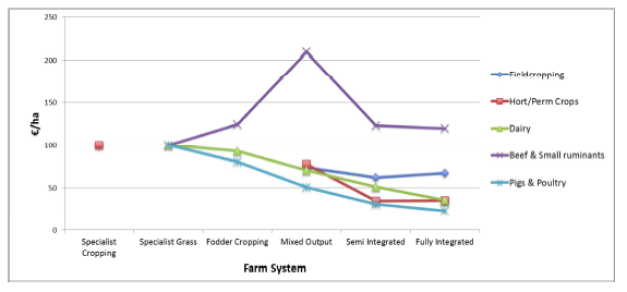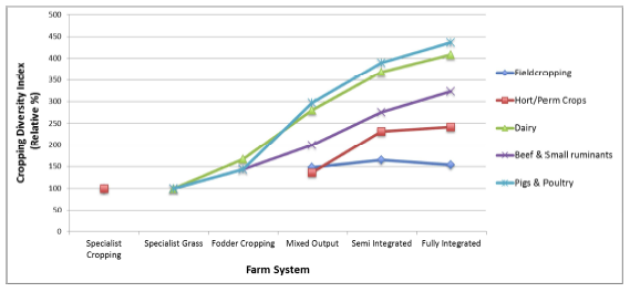Conclusion of the economic assessment
Overall, the results appear to demonstrate that in many cases the specialised (SG, FC) and mixed output (MO) farms achieved higher output through greater use of external inputs and ultimately were more profitable, as demonstrated in Figure 7 below showing relative median Farm Net Income (with SC as 100% for cropping farm types and SG as 100% for livestock farm types). However, the diverse range of enterprises and reduced reliance upon external inputs on integrated farms means they are less sensitive to input and output price fluctuations, as identified by Wilkins, (2008).

In terms of labour requirements, whilst some samples did not highlight differences between systems, Figure 8 below (showing the relative percentage differences in labour use per 100 hectares, with SC as 100% for cropping farm types and SG as 100% for livestock farm types), appears to indicate that overall mixed and integrated farms required greater labour input.

In terms of environmental indicators, it was clear from almost every comparison that the FI farms had significantly lower expenditure on external inputs of feed, fertiliser and crop protection products (see Figure 9, below), combined with high cropping diversity (see Figure 10), as well as lower livestock stocking densities.
In summary, the results of this analysis support previous work comparing specialised and mixed farm systems. Results indicate that whilst some mixed or integrated farm systems achieve similar profitability to more specialised systems, in general they require more labour, have lower productivity and reduced profitability, but in terms of environmental indicators, use less external inputs, provide high cropping diversity and lower stocking rates. However, the analysis indicates that despite better environmental indicator performance the mixed and integrated farms generally receive lower levels of financial support through the CAP and do not appear to have received compensation for income foregone through more environmentally friendly farming. The introduction of greening policies within the CAP may however change this situation.